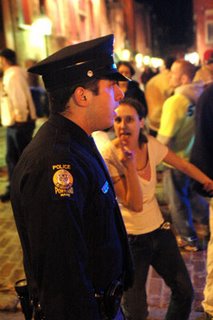Fore Street is as integrally a part of Portland as the far busier main thoroughfare, Congress Street. Its crooked course, lined with rows of weathered often ramshackle, brick and frame buildings, indicates the contours of the original Portland waterfront. Fore and contiguous streets which once were lanes bearing such names as Love, Fiddle, Fish, Lime, Turkey, and Moose Alley were long the commercial and residential centers of the city, and comprise the district which suffered most from the fire of 1866.
Longfellow recalled the Fore Street of his youth, with its "black wharves and the slips... and the Spanish sailors with bearded lips," when the fashionable residential section still lay east of Congress Street. Here on Fore Street were the counting-houses, chandleries, slopshops, saloons, lodging-houses, and the warehouses crammed with West Indian goods. ... Later on in its history certain section so Fore Street acquired an unsavory reputation.
With the laying out of Commerical Street in the middle of the 19th century, Fore was relegated to a position of secondary importance, but suffered only light diminution of activity. .... Many of its buildings are the tombs of a former prosperity and, whereas midnight was once but another hour to the scores of brawling and carousing sailors who frequented the street, its silence is now broken only by an occasional, perhaps furtive, footfall or the caterwauling of the stray cats that live in the deserted lofts and cellars.
In the 1960s art shops were becoming the vogue in the area. ... In 1850 increased trade and the projected railway to Canada seemed to demand better and more ample transportation and terminal facilities than were possible on Fore Street, which at that time bordered the water. Accordingly, in that year, Commerical Street, 100 feet broad, more than a mile long, with a 26-foot space in its center reserved for the railroad, was laid out across tidewater, running over the heads of the wharves. The area between Commercial and Fore Streets was later filled in; the drop between the levels of the two streets is noticeable today. Thus, leaving Fore Street stranded, Commercial Street became the focus of maritime activity and trade.

Today the street is once again awash with carousing, though relics of its history are found tucked carefully along its length mixed in with modern treasures, including the wonderful presence of a very special red parrot named Singapore at the China Sea Marine Trading. I'm going to try to interview the parrot's human companion (Steve, the owner) in the near future, see if I don't!
Photo of Old Port rowdies by Matthew Robbins, for The Bollard.
No comments:
Post a Comment